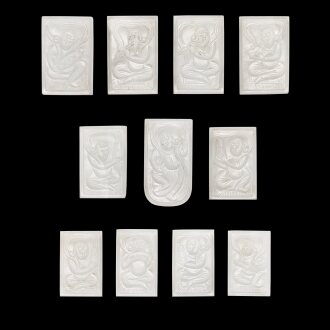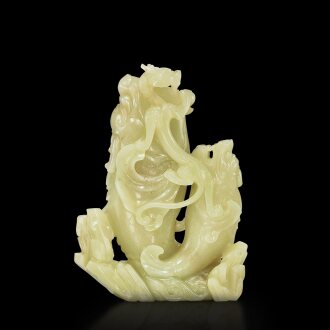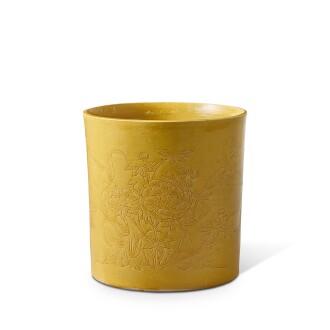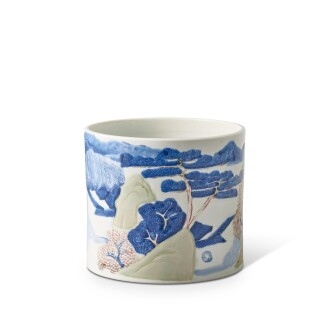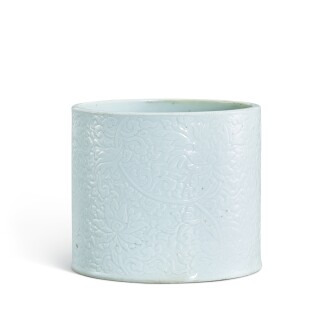As nature's splendors come into view, My heart longs for their rendezvous.
In the realm of "Monochrome" – a term signifying a single hue – lies a beauty transcending mere color, delving into the essence and inherent nature of objects. "Monochrome," the quintessence of all things, bespeaks a world teeming with life, wherein only humans can create: with varying skills come masterful or clumsy works; with diverse temperaments arise the refined or the vulgar. Each object, each vessel, possesses a character that resonates with its creator and collector, and it is within this harmony that joy is born. Wang Yangming, in a letter to his student Huang Mianzhi, wrote: "Joy is the essence of the heart. The benevolent heart perceives all things in heaven and earth as one, unified in harmony, with no separation."
In truth, no chasm exists between humans and objects, yet an affinity must be found. The refined cannot abide the mundane, while the ordinary's possession of elegance leads to the squandering of nature's gifts. Monochrome concerns itself with aesthetics, and in this curated selection, simplicity and grace take center stage. Stripping away ostentation, we seek to reach the heart of Chinese art through a path unencumbered by superficial colors.
物華方入賞,跋予心期會。
「物華」專場的英文 Monochrome 本為單色之意,而意趣遠在顔色之外,近乎器物之本色與秉性。「物華」本意萬物精華,天地生萬物,然而唯有人可以造物:技有優劣,所以物有巧拙;品格高低,所以物有雅俗。一物一器皆有性格,又與作者、藏者相應和,應和之間便生樂趣。王陽明在給學生黃勉之的信中說:「樂是心之本體,仁人之心,以天地萬物為一體,訴合和暢,原無間隔。」人與物之間本無間隔,然而需得匹配,雅士俗物自不相容,凡夫雅物便是暴殄天物了。物華關乎審美,專場選物以簡雅爲主,擯除浮華,是爲諸離色相中直抵初心的方便法門。


The door of Tang dynasty China opened wide to welcome a confluence of cultures, near and far, whose influence runs deep. In those days, emperors esteemed grandeur, adorning their courts with objects wrought from gold, silver, and precious glass, their intricacies resplendent and ornate. Time has borne away these treasures, leaving but a few; yet the legacy of the sancai wares endures, a window cast open on the vast ocean of the past, inviting future generations to gaze upon the splendor of the Tang, the thriving Silk Road culture of the day.
The arts thrived in the Tang era, urging potters to innovate, to embrace new winds and forge their own paths, crafting marvels of technique like imprinting, molding, stippling, appliqué, resist, and marbling. Colors grew richer, hues of yellow, green, and blue prevailing, their pleasing shades dappling light and dark, the dance of change made manifest. Among these, the blue-glazed wares earned the highest esteem, their cobalt first employed in the Tang around the 8th century, an exquisite rarity imported from the Middle East. The tri-colored pottery of the Tang blossomed into a style all its own, a cornerstone of Chinese ceramics that, despite the myriad innovations of the ages, has held its place, enduring through a thousand years.
史海幽幽,大唐盛世,時廣開國門,中外文化匯集,影響尤深。其時帝皇崇尚華貴之風日甚,宮廷所用器物悉用金、銀、琉璃等珍貴材料製成,工藝繁縟富麗。時移境遷,至今此類唐物所存甚罕,而三彩器之存世則彷若是在蒼茫史海之上打開了一扇窗口,供後世仰視遙思,一窺泱泱大唐之盛世景象,當朝蓬勃發展的絲路文化。
大唐文藝蓬勃,彼時陶匠皆務求創新,採納新風而自成一格,工藝越見奇巧,如印花、陶模、點彩、貼花、蠟封、絞胎等。色系更趨豐富,以黄、綠、藍三彩為主色,彩色清麗怡人,濃淡斑駁,尤顯變幻之美。然三彩器中以施藍彩者最受推崇,藍彩始用於唐代約八世紀,其時鈷料極純,需從中東進口,珍貴無比。唐代三彩陶器漸蔚然成風,成為中國陶瓷一大品種,即使後世創新色釉品種不斷,卻仍可獨占一席,流傳千載而不衰。

The Song aesthetic is found in ‘skies clearing after rain’ (Yuyao celadon), and in the ‘delicate shadows cast by rabbit fur on purple-glazed wares’ (Jian wares). Song ceramics strike a subtle balance between complexity and simplicity, finesse and rusticity, elegance and the common touch. The white of Ding ware, the green of Longquan, and the patterns of Cizhou—too much, and they are garish; too little, and they falter. This section presents an array of Tang and Song ceramics from Japanese and international private collections, including several exquisite marbled wares from the Song dynasty.
Marbled wares, first created in the Tang era, borrow techniques from lacquer craft, blending two shades of clay to form the body or applying dual-colored clay strips to the finished vessel, a complex process. Song marbled wares were renowned and predominantly produced in Henan, at kilns such as Dengfeng, Dangyangyu, Baofeng, Xin'an, and Wuxiu. Using different-colored clay, they fashioned patterns of feathers, leaves, wood grain, and clouds. The marbled wares displayed here showcase the artisans' skillful hands, with textures both strikingly distinct and ethereally subtle, as if whispered by passing clouds.
宋人之審美在雨過天青,也在兔毫紫甌。宋瓷的特質在繁簡、巧拙、雅俗之間取得微妙平衡。定瓷之白,龍泉之青,磁州之花,多一分則艷,少一分則蹇。本場呈現多組日本及海外私人珍藏之唐宋瓷器,當中包括數件宋代絞胎小品,精緻可人。絞胎,唐朝始創,借鑑漆器工藝,取兩色胎土混合製胎,或以雙色土條貼於成器胎上而成,工藝複雜。宋代絞胎名噪一時,多在河南燒製,包括登封窰、當陽峪窰、寶豐窰、新安窰及武修窰。用不同顏色胎土絞成不同圖案包括羽紋、葉紋、木紋、雲紋等。是次所呈絞胎器紋理秀朗,既有層次分明者、也有流雲淡雅者,展現匠心巧技。

The scholar's study has long been a haven for cultivating one's character, finding solace, and enjoying leisure through the written word. Adorned with books, paintings, and prized curios, it is a reflection of the master's quest for inner spirituality and the pursuit of aesthetics. Skilled in the dance of brush and ink, the scholar's desk is incomplete without a practical pen holder. Crafted from ceramics, bamboo, jade, lacquer, or glass, the holder's adorned patterns bear symbolic meanings, while popular scenes of reclusive scholars in the mountains or historical tales remind us that even when confined indoors, one can still revel in the pleasure of a wandering mind.
文人書房的理想境界是「圖書滿壁,落葉滿床」,惟嫌太過清苦,於是案頭便多了竹木牙雕,墻上多了金石書畫,屋內陳設了紫黃雞翅,方寸之間,足不出戶,便可作遨遊想。宋代以來文人便積極參與到文房器物製作,蘇東坡造墨,米元章硾紙,邵康節斫琴,文三橋治印,陳曼生範陶,所以器近乎道,不能以物視之。

Following the success of our May and November auctions in 2022, we are delighted to present the third installment from the Alleyne Collection, featuring thirteen lots (lot 376-388) for the scholars’ table assembled by two passionate collectors since the 1970s. The couple are erudite admirers of Chinese art as well as beneficent donors to the British Museum in London. Highlights of the group include a unique and rare incised yellow-glazed 'peony and chrysanthemum' brushpot from the Transitional period, previously featured in the well-known exhibition Transitional Wares and Their Forerunners and on loan to Ashmolean Museum, Victoria and Albert Museum and T.T. Tsui Gallery.

程尚文及程王蘅伉儷,攝於倫敦大英博物館玉器展廳
繼上年五月及十一月拍賣佳績,本季欣呈程尚文伉儷珍藏第三部分。程氏伉儷醉心研究中國古瓷,自七十年代開始蒐集文案珍瓷,為人樂善好施,乃倫敦大英博物館的捐贈者。是次拍賣所呈十餘件套(拍品編號376-388),不乏文房用品,如明末清初黃釉劃花卉紋筆筒,牡丹秋菊、蝴蝶草蟲,置案桌之上,格外清逸。曾收入香港藝術館、牛津阿什莫林博物館、倫敦維多利亞與艾爾伯特博物館、香港徐展堂中國藝術館展覽,尤為難得。



